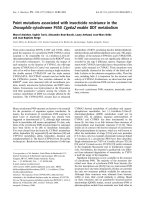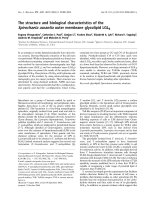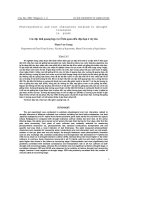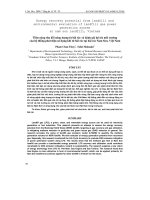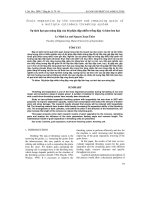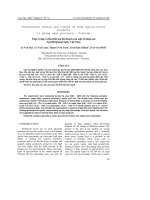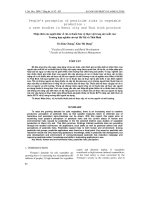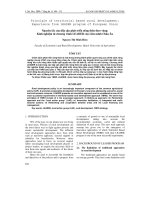Scientific report: "The photosynthesis and root characteristics associated with drought tolerance in rice" potx
Bạn đang xem bản rút gọn của tài liệu. Xem và tải ngay bản đầy đủ của tài liệu tại đây (217.42 KB, 9 trang )
J. Sci. Dev. 2009, 7 (Eng.Iss.1): 1 - 8 HA NOI UNIVERSITY OF AGRICULTURE
1
Photosynthetic and root characters related to drought
tolerance
in plant
Các đặc tính quang hợp và rễ liên quan đến chịu hạn ở cây lúa
Pham Van Cuong
Department of Food Crop Science, Faculty of Agronomy, Hanoi University of Agriculture
TÓM TẮT
Thí nghiệm trong chậu được tiến hành nhằm đánh giá các đặc tính sinh lý và đặc tính rễ liên quan
đến tính chịu hạn của các giống lúa bao gồm lúa nước loài phụ indica, lúa nước loài phụ Japonica, lúa
lai từ dòng bất dục đực nhân mẫn cảm nhiệt độ và loài lúa dại để so sánh với giống lúa Indica chịu hạn.
Ở giai đoạn đẻ nhánh hữu hiệu, các chậu thí nghiệm được rút cạn nước rồi để khô trong vòng 4 ngày,
sau đó được tưới nước trở lại. Ở giai đoạn trước rút nước, hạn và sau phục hồi (sau tưới nước 4 ngày),
chọn ngẫu nhiên 4 chậu của mỗi giống để đo các chỉ tiêu về quang hợp như cường độ quang hợp, độ
dẫn khí khổng, cường độ thoái hơi nước và chỉ số khối lượng riêng của lá (một chỉ tiêu đánh giá độ dày
lá). Những cây đo quang hợp được chọn để đo độ dẫn nước và các đặc tính về rễ như chiều dài rễ tối
đa, số lượng rễ và khối lượng rễ khô. Khi xử lý hạn hầu hết các đặc tính quang hợp như cường độ trao
đổi CO
2
, độ dẫn khí khổng và cường độ thoát hơi nước đều giảm mạnh ở lúa lai F1 và lúa dại tương tự
như ở giống lúa chịu hạn (CH5), trong khi đó những chỉ tiêu này giảm ít hơn ở các giống lúa khác.
Ngược lại những chỉ tiêu này lại phục hồi tốt hơn ở lúa lai F1 lúa dại và giống lúa chịu hạn so với ở các
giống khác. Cường độ quang hợp tương quan thuận với độ dẫn khí khổng và cường độ thoát hơi nước
ở tất cả các giống lúa ở giai đoạn hạn và phục hồi, tuy nhiên tương quan này không ở mức ý nghĩa tại
giai đoạn trước rút hạn. Cường độ quang hợp và chỉ số diệp lục (SPAD) có tương quan thuận ở giai
đoạn trước rút hạn và sau phục hồi, tuy nhiên tương quan này lại âm ở giai đoạn hạn. Cường độ quang
hợp có tương quan thuận với số lượng rế/cây ở giai đoạn phục hồi.
Từ khoá: Cây lúa, chịu hạn, kiểu gien, quang hợp, rễ.
SUMMARY
The pot experiment was conducted to estimate physiological and root characters related to
drought tolerance of different cultivated rice cultivars including low land Indica subspecies, low land
Japonica subspecies and F1 hybrid from thermo-sensitive genic male sterile line and wild rice specie
(Oryza Rufipogon) in compared with drought tolerance cultivar (Indica low land rice). At the active
tillering stage, the plants were moved out all waters the kept dried during for four days, after that the
pots were recovering. Four plant of each cultivars was randomly selected for measuring
photosynthetic characters viz., photosynthetic rate, stomatal conductance, transpiration rate and
specific leaf area (SLA a revert indicator of leaf thickness). The plant measured photosynthetic
characters were sampled for measuring water conductance and root characters such as root length,
number of root per plant and root dry weight. As drought treatment, most photosynthetic character
such as CO
2
exchange rate, stomatal conductance and transpiration rate decreased in F1 hybrid and
wild rice as much as in drought tolerance cultivar (CH5), whereas they were much higher in the other
cultivars. In contrary, these characters recovered in all F1 hybrid, wild rice and check cultivar were
quite higher than those in the others at recovering stage. Photosynthetic rate were significantly and
positively correlated with stomatal conductance and transpiration rate in all rice cultivars at both
drought and recovering stages, whereas the correlation was not significant at before drought stage. A
correlation between CER and SPAD was observed to be positive at before drought and recovering
stages, however it was negative at drought stage. CER was positively correlated with the number of
root per plant at recovering stage.
Journal of Science and Development 2008: Tập VI, No 6: 179- HA NOI UNIVERSITY OF AGRICULTURE
2
Key words: Drought tolerance, photosynthesis, rice plant, root.
1. INTRODUCTION
Water is essential to plant growth because it
provides the medium within which most cellular
functions take place. Nowadays, the restricted
availability of water resource has focused attention.
On paddy and upland fields where the irrigation
water depends mainly on rainfall, rice plants are
often exposed to drought (O'Toole, 1982). On the
other hand, about 70% of the rice cultivation area in
Southeast and South Asia, which is about half of
the total world production, depends on irrigation
from rainfall. From the worldwide viewpoint, the
fact indicates that studies on drought resistance are
very important at present. According to
mechanisms of drought resistance, the responses to
drought in plants relate to photosynthetic rate,
stomatal conductance, transpiration rate, leaf
rolling, enhanced root growth, specific leaf area
and so on. Accumulated evidence suggests that
both chemical and hydraulic signal are operative
and integrated in the regulation of leaf growth and
stomatal conductance when plants grown under
drought stress (Davies et al., 1994; Comstock,
2002). The hydraulic signals involve changes in
pressure potential in the xylem and changes in
water content of the guard cells and other epidermal
cells. The chemical signals relate to abscisic acid
(ABA), which is synthesized in roots under water
stress and transported to leaves and/or together with
ABA synthesized in the leaves themselves, induce
stomatal closure. Also, root development is
fundamentally involved in the response to many
plant stresses, such as drought (Adam et al., 2002).
The possession of a deep and thick root system
which allows access to water deep in the soil
profile is considered crucially important in
determining drought resistance in upland rice and
substantial genetic variation exists for this (Fukai
and Cooper, 1995; O'Toole, 1982; Yoshida and
Hasegawa, 1982). The drought resistance of
cultivated plants, including rice plants, refers not
only to their specific ability, such as survival
capacity or subsequent recovering ability, but also
to their integrated abilities in the production
processes through their growing period (Fukai and
Cooper, 1995; Mambani and Lal, 1983). In this
study, we estimated the drought tolerance in F
1
hybrid, wild rice, upland rice and low land rice
cultivars in compared with drought tolerance rice at
the active tillering stage by measuring the
photosynthetic rate, stomatal conductance, water
conductance and root characters.
2. MATERIALS AND METHODS
2.1. Plant Materials
The experiments were carried out with 8
different rice cultivars: CH5 (Drought resistance
used as check cultivar), Khau Suu (local upland
rice cultivar), 103S (low land, TGMS line -indica),
R20 (low land, restorer line- indica), Oryza
Rufipogon (wild rice species), Vietlai 20 (F
1
hybrid
rice - 103S/R20), Lily 328 (low land rice,
susceptible for drought, japonica): and Toitsu (low
land rice, susceptible for drought, japonica). The
experiments were set in green house in Faculty of
Agronomy, Hanoi University for Agriculture,
Vietnam during spring cropping season in 2006.
2.2. Planting
Seed of rice cultivars were incubated and
sown in the seedling bed (60 x 35 x 8 cm). Seedling
at the 3 - 4- leaf stage was transplanted singly into
Wager pot (0.02 m
2
), one seedling per one pot
(Gomez and Gomez, 1984).
2.3. Fertilization
Total fertilizer was applied with N, P
2
O
5
and
K
2
O was at the rate of 0.48, 0.36 and 0.36 (g per
pot), respectively. Basal dressing for one pot with N,
P
2
O
5
and K
2
O was at the rate of 0.16, 0.18 and 0.12
g, respectively. Top dressing at 7 DAT and 14 DAT
with N, P
2
O
5
and K
2
O at the rate of 0.08, 0.18 and
0.08 g, respectively. Final dressing at the panicle
initiation stage (20-18 days before heading) was
applied with N and K
2
O at the same rate of 0.06 g.
2.4. Drought treatment
At the active tillering stage (30 days after
transplanting), all the water inside in the pots were
moved out then the pots were kept dried during 4
days, after that re-watering (O'Toole, 1982; Fukai
and Cooper, 1995).
2.5. Measurement
Photosynthetic parameters: At three stages as
before draining, during drought treatment and 4 days
after recovering, 4 plants of each rice cultivars were
randomly selected for measuring photosynthetic
Pham Van Cuong
3
characters. Two top-fully expanded leaf of each
plant was selected for measuring CO
2
exchange rate
(CER), transpiration rate (Tr) and stomatal
conductance (gs) using LICOR 6400, at temperature
of 30
o
C, light intensity of 1500 mol/m
2
/s and CO
2
concentration of 370 ppm.
The plants measured photosynthesis were
selected for measuring SPAD value (an indicator of
chlorophyll content) using SPAD, Motorola, 502,
Japan, Specific leaf area (SLA), water conductance
and root characters: The leaf measureed CER was
sampled for measuring leaf area using ANA-GA-5,
Japan, then dried at 80
o
C for 48h for calculating SLA.
SLA = Leaf area/ Leaf dry weight
Water conductance: The plants were cut at 5
cm high from the base of plant and use dry cotton
to cover the stem. After two hours the cotton was
weighted for calculating water conductance.
Root characters: The plants were selected
maximum root length and counted the number of
active root per plant. The roots of each plant were
dried at 80
o
C for 48 hours for root dried weight
measurement.
Statistical analysis: Data was analyzed by
SAS program Ver.8.2, (1990) after Shinjo
(1994)[f1]. Means were tested by least significant
difference at P0.05 level . At each stage, correlation
among photosynthesis and root characters were
calculated of 4 plants considered as 4 replications.
3. RESULTS AND DISCUSSION
CO
2
Exchange Rate: Table 1 showed that the
CO
2
exchange rate (CER) of all 8 cultivars
decreased under drought condition (measured 4
days after draining) and increased in recovering
stage (4 days after watering). The CER decreased
in wild rice (Oryza Rufipogon; from 31.23 molm
-
2
s
-1
to 18.46 molm
-2
s
-1
) and F1 hybrid (Vietlai 20;
from 30.47 molm
-2
s
-1
to 20.18 molm
-2
s
-1
) as
much as in check cultivar (CH5; from 32.36
molm
-2
s
-1
to 15.65 molm
-2
s
-1
), but it was higher
than that in the others cultivars. After recovering,
the CER value in both CH5 (31.32 molm
-2
s
-1
) and
F1 hybrid (28.74 molm
-2
s
-1
) were almost the same
as it before draining. However at recovering stage,
the CER of Oryza Rufipogon was lower than that of
other cultivars, and lower than that at before
draining stage.
Stomatal Conductance (Gs): The stomatal
conductance of all rice cultivars reduced after
draining and increased after recovering (Table 2).
The Gs of CH5, Oryza Rufipogon and Vietlai 20
dropped significantly during drought treatment
(especially with CH5, Oryza Rufipogon) and
recovered to the same level as of the well-watered
treatment (with CH5 and Vietlai 20). This may be
the changes in pressure potential in the xylem and
changes in water content of the guard cells and
other epidermal cells (Davies et al.,1994;
Comstock, 2002). CER was not correlated with and
stomatal conductance in all rice plant at before
draining stage (r = 0.28), whereas it was significant
at drought at (r = 0.90) and recovering stage (r =
0.59). This might be due to abscisic acid (ABA),
which is synthesized in roots under water stress and
transported to leaves and induce stomatal closure
(Davies et al .,1994).
Table 1. CO
2
exchange rate of rice cultivar at the active tillering stage (mol m
-2
s
-1
)
Cultivars Before draining 4 days after draining 4 days after recovering
103S /R20 30.47 20.18 28.74
R20 32.09 24.23 29.81
103S 33.22 27.7 28.93
CH5 (check) 32.36 15.65 31.32
Khau Suu 28.28 22.62 25.88
Oryza Rufipogon 31.23 18.46 24.97
Photosynthetic and root characters related to drought tolerance in plant
4
Lily 328 32.75 26.85 30.64
Toitsu 32.20 22.33 31.12
LSD5% 1.31 1.87 1.07
Table 2 . Stomatal conductance of rice cultivar at the active tillering stage (mol m
-2
s
-1
)
Cultivars Before draining 4 days after draining 4 days after recovering
103
S
/R20 0.70 0.10 0.80
R20 0.84 0.26 0.80
103
S
0.65 0.32 0.61
CH5 (check) 0.84 0.03 0.81
Khau Suu 0.52 0.26 0.67
Oryza Rufipogon
0.49 0.04 0.29
Lily 328 0.45 0.30 0.56
Toitsu 0.70 0.14 0.90
LSD5% 0.13 0.05 0.12
Fig. 1. Correlation between CO
2
exchange rate (CER) and stomatal conductance (gs)
in rice cultivars before draining (A), 4 days after draining (B) and 4 days after recovering stages (C)
B
y = 28.83x + 17.21
r = 0.90***
15
17
19
21
23
25
27
29
0.0 0.2 0.4 0.6 0.8 1.0
CER
(
molm
-2
s-1
C
y = 8.60x + 23.02
r = 0.59*
23
25
27
29
31
33
0.0 0.2 0.4 0.6 0.8 1.0
Gs(molm
-2
s
-1
)
Ay = 2.7202x + 29.754
r = 0.26
27
29
31
33
35
0.0 0.2 0.4 0.6 0.8 1.0 1.2 1.4 1.6
O.Rufipo gon
CH5
Vietlai20
R20
Khausuu
103s
Lily
Toitsu
Pham Van Cuong
5
Transpiration rate: Similar to the changes of
photosynthetic rate and stomatal conductance,
transpiration rate of all rice cultivars decreased
after draining water and recovered almost similar to
the same of that after recovering (Table 3). As
drought treatment, transpiration rate reduced
significantly and strongly in CH5, following in
Vietlai 20 and Oryza Rufipogon. The reduction was
less in the other cultivars than that in check variety.
The reduced in transpiration rate cause to reduce
the effect of water deficit, the early drought
adaptation of plants. Thus, both the F1 hybrid and
wild rice could be good for drought tolerance. At
recovering time, the transpiration rate increased to
the same of that before with CH5, little bit higher
than before with Vietlai 20, Toisu , Khau Suu and
Lily 328. A significant and positive correlation was
observed between CO
2
exchange rate and
transpiration rate during drought condition (r = 0.89)
and recovering time (r = 0.78), whereas it was not
significant at the time before draining (r = 0.31)
(Fig.2). At the drought time, which cultivars had
transpiration rate reduced much, that cultivars
would had low CER (CH5, F1 hybrid and wild
rice). At the recovering time, the transpiration rate
of CH5 and F1 hybrid were similar before and the
CER could recover well. The lower transpiration
rate in F1 hybrid and wild rice which is similar to
check cultivars was caused by better stomatal
system.
Table 3 . Transpiration rate of rice cultivar at the active tillering stage (mmol m
-2
s
-1
)
Cultivars Before draining 4 days after draining 4 days after Recovering
103
S
/R20 8.96 0.39 10.26
R20 10.55 4.38 9.71
103
S
9.94 4.53 8.88
CH5 (check) 11.82 0.53 11.15
Khau Suu 8.44 4.00 9.48
Oryza Rufipogon
8.24 1.02 5.34
Lily 328 8.04 6.09 9.34
Toitsu 7.94 3.89 11.31
LSD5% 1.06 0.89 1.35
A
y = 0.35x + 28.26
r = 0.31
27
29
31
33
35
0 2 4 6 8 10 12 14
B
y = 1.70x + 16.97
r = 0.89**
15
20
25
30
0 2 4 6 8 10 12 14
CER(mmolm
-2
s
-1
)
C
y = 0.99x + 19.54
r = 0.78**
23
25
27
29
31
33
0 2 4 6 8 10 12
Tr (mmol m
-2
s
-1
)
Fig. 2. Correlation between CO
2
exchange
rate (CER) and transpiration rate
(Tr) in rice cultivars before draining
(A), 4 days after draining (B) and
4 days after recovering stages (C).
Note: Symbols were the same as
shown in Fig.1
Photosynthetic and root characters related to drought tolerance in plant
6
SPAD value: There were non-significant
differences in SPAD values in all rice cultivars
during three stages of experiment (Table 4). At
before draining and drought stage, the SPAD of
each cultivars were almost the same each other. At
recovering stage, the SPAD decreased in Khau Suu,
Oryza Rufipogon, 103S, Vietlai 20 and CH5.
Among of them, the decrease was much in Khau
Suu, following in 103S, Vietlai 20, Oryza
Rufipogon and CH5. Rice plants grown under water
deficit, the SPAD reduced with cultivars which
were considered to be drought resistance.
The correlation between CER and SPAD was
shown in Fig.3. CER was positively correlated
with SPAD value at both before draining stage
(r = 0.41) and recovering stage (r = 0.57), but the
correlation was not significant at drought stage
(r = -0.34)
Table 4. SPAD value of rice cultivars at the active tillering stage
Cultivars Before draining 4 days after draining 4 days after recovering
103
S
/R20 38.39 39.30 36.04
R20 40.83 39.58 41.33
103
S
36.87 37.65 33.99
CH5 (check) 39.08 40.49 38.63
Khau Suu 36.20 35.46 31.16
Oryza Rufipogon
39.20 38.85 37.50
Lily 328 38.97 39.51 41.27
Toitsu 37.89 38.91 37.94
LSD5% 1.75 2.30 2.45
A
y = 0.44x + 14.38
r = 0.41*
27
29
31
33
35
30 32 34 36 38 40 42
B
y = -0.90x + 57.48
r = -0.34
15
17
19
21
23
25
27
29
30 32 34 36 38 40 42
CER (mmolm
-2
s
-1
)
C
y = 0.39x + 14.34
r = 0.57*
20
22
24
26
28
30
32
30 32 34 36 38 40 42
SPAD
Pham Van Cuong
7
Fig. 3. Correlation between CO
2
exchange rate (CER) and SPAD in rice cultivars before draining (A),
4 days after draining (B) and 4 days after recovering stages (C).
Note: Symbols were the same as shown in Fig.1.
Specific leaf area (SLA): Vietlai 20 has the
highest value of SLA, following are 103S, R20,
Toisu, Lily 328, Khau Suu, CH5 and Oryza
Rufipogon has the lowest value of SLA (Table
5). Water evaporation through leaf is a driving
force of water flow from root to shoot. When
water evaporation is low, root pressure plays an
important role to maintain the water flow from
root to shoot. The specific leaf area of plants is
one of the genotype that related to genetic. Many
observations pointed that cultivars that have thin
leaves (the value of SLA is high) that cultivars
are considered to be drought resistance. Because
of thin blade, leaf will be easy to roll up to
reduce CO
2
exchange rate, stomatal conductance
and transpiration rate. CH5 and Oryza Rifipogon
had smallest value of SLA.
Root characters: The cultivar that had the
longest maximum root length is CH5, following are
KhauSuu, Oryza Rufipogon, Toitsu, Vietlai 20, Lily
328, R20 and 103S. It means CH5 and Oryza
Rufipogon had deeper roots (Table 5), which
increasing the ability to extract soil water from depth
(Mambani and Lal, 1983a,b,c; Yoshida and
Hasegawa, 1982). Despite the longest root length,
the number of root per plant was much higher in F1
hybrid (292) than that in CH5 (211) and Oryza
Rufipogon (232), indicating that the F1 hybrid had
thick root system, which also allows access to water
deep in the soil profile is considered crucially
important in determining drought resistance in
upland rice and substantial genetic variation exists
for this (Ekanayake et al., 1985b; Fukai and Cooper,
1995; O'Toole,1982; Yoshida and Hasegawa, 1982).
A significant and positive correlation was observed
between CER and the number of root per plant in all
rice cultivars at recovering stage, indicating that the
greatest thick root system in F1 hybrid not only
contributed to resistance during drought condition
but also at recovering stage.
Water conductance: Water conductance
from root to stem was shown in Table 5. In
detail, the water conductance of Vietlai 20, CH5
and Toitsu was 0.55, 0.49 and 0.46, respectively,
and it was higher than that in the other cultivars.
The result indicates that the cultivars had high
value of water conductance, that also had high
value of photosynthesis, stomatal conductance
and transpiration rate at recovering stage and it
contributed to drought resistance
Table 5. Specific leaf area (SLA), root characters and water conductance
in rice cultivars at recovering stage
Cultivars
SLA
(cm
2
g
-1
)
Maximum root length
(cm)
Number of
root plant
-1
Root dry weight
(g plant
-1
)
Water conductance
(mg plant
-1
s
-1
)
103
S
/R20 259.68 24.81 292.00 7.54 0.55
R20 227.48 22.63 252.33 6.94 0.33
103
S
234.31 19.76 275.33 6.89 0.38
CH5 (check) 200.89 27.83 211.00 6.66 0.49
Khau Suu 219.99 27.75 247.33 6.03 0.40
Photosynthetic and root characters related to drought tolerance in plant
8
Oryza Rufipogon
197.29 27.70 232.00 4.17 0.29
Lily 328 223.48 24.83 283.66 3.56 0.38
Toitsu 227.52 25.00 283.00 4.84 0.46
LSD5% 21.27 1.17 17.17 0.75 0.05
Fig. 4. Correlation between CO
2
exchange rate (CER) and number of root per plant in
rice cultivars at recovering stage
Note: Symbols were the same as shown in Fig.1
4. CONCLUSION
Among rice cultivars, F1 hybrid (Vietlai 20) and
wild rice (Oryza Rufipogon) was the best for
photosynthetic characters which similar to check
cultivar for drought tolerance.
During drought condition, low photosynthetic rate
and transpiration rate caused by low stomatal
conductance contributed to drought tolerance in
rice plant.
The larger number of root per plant was the reason
for better recovering of rice plant after drought
treatment.
REFERENCES
Adam HP, Jill EC, Peter H, Hamlyn GJ, Howard G.
(2002). Linking drought-resistance mechanisms
to drought avoidance in upland rice using a QTL
approach: progress and new opportunities to
integrate stomatal and mesophyll responses.
Journal of Experimental Botany 53,989-1004.
Comstock JP. (2002). Hydraulic and chemical
signalling in the control of stomatal conductance
and transpiration. Journal of Experimental Botany
53,195-200.
Davies WJ, Tardieu F, Trejo CL. (1994). How do
chemical signals work in plants that grow in
drying soil? Plant Physiology 104,309-314.
Ekanayake IJ, O'Toole JC, Garrity DP, Masajo TM.
(1985). Inheritance of root characters and their
relations to drought resistance in rice. Crop Science
25, 927-933.
Fukai S, Cooper M. (1995). Development of
drought-resistant cultivars using physio-
morphological traits in rice. Field Crops
Research 40, 67-86.
Gomez, K.A. and Gomez, A.A. (1984). Statistical
Procedure for Agricultural Research.
Mambani B, Lal R. (1983a). Response of upland
rice varieties to drought stress. I. Relationship
between root system development and leaf water
potential. Plant and Soil 73, 59-72.
y = 0.0935x - 2.0157
r = 0.66*
14
16
18
20
22
24
26
28
30
200 220 240 260 280 300
Number of root plant
-1
CER (
mol m
-2
s
-1
)
Formatted: Bullets and Numbering
Pham Van Cuong
9
Mambani B, Lal R. (1983b). Response of upland
rice varieties to drought stress. II. Screening rice
varieties by means of variable moisture regimes
along a toposequence. Plant and Soil 73, 73-94.
Mambani B, Lal R. (1983c). Response of upland
rice varieties to drought stress. III. Estimating
root configuration from soil moisture data. Plant
and Soil 73, 95-104.
O'Toole JC. (1982). Adaptation of rice to drought-
prone environments. In: Drought resistance in
crops with the emphasis on rice. Manila: IRRI,
195-213.
Shinjo, A. (1994). Introduction to Statistics by PC
SAS. (in Japanese) Tokai Univ. Press, Hadano,
pp 195.
Yoshida S, Hasegawa S. (1982). The rice root
system, its development and function. In:
Drought resistance in crops with the emphasis on
rice. Manila: IRRI, 83-96
